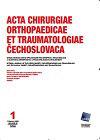[Intramedullary Nailing in Managing Diaphyseal Metastases of Long Bones: Retrospective Study Comparing the Expected Survival and the Actual Survival of Patients].
IF 0.4
4区 医学
Q4 ORTHOPEDICS
Acta chirurgiae orthopaedicae et traumatologiae Cechoslovaca
Pub Date : 2022-08-15
DOI:10.55095/achot2022/043
引用次数: 1
Abstract
PURPOSE OF THE STUDY The paper focuses on the potential use of nail osteosynthesis in diaphyseal metastases of long bones. The purpose of the paper is to assess the outcomes of intramedullary osteosynthesis in pathologic and impending pathologic fractures, to evaluate patient survival and potential complications. MATERIAL AND METHODS The retrospective study evaluated a cohort of 42 patients (19 men and 23 women) in whom intramedullary osteosynthesis was performed for complete pathologic fracture (28 patients) or impending pathologic fracture (14 patients) between 2010 and 2019. Of the total number of 42 patients, 31 patients' lower limbs were affected, namely by 17 pathologic fractures and 14 impending fractures. There were 11 humerus fractures. The mean age was 61.8 years (range 41-84 years). In the followed-up cohort, the patient survival after osteosynthesis with intramedullary nails, complications occurred and post-operative mobility of the patient were assessed. The functional outcomes were evaluated using the Musculoskeletal Tumor Society (MSTS) scoring system. The unpaired Mann-Whitney test was used to test the significance of the difference in functional outcomes and survival between the followed-up groups. Survival longer than 6 months was evaluated using Fisher's exact test. The level of statistical significance used for the test was p 0.05. RESULTS The investigated indicator was patient survival, which was 11.3 months (range 1-50 months) on average. In the group of impending fractures, the mean survival was 13.5 months. In the group of pathologic fractures, the survival was 10 months. The functional outcome in 16 followed-up patients at three months after intramedullary osteosynthesis according to the MSTS score was 46.9% (30-66.7%). At the level of significance of p 0.05, the statistically significant difference in the functional outcomes between the group with preventive intramedullary osteosynthesis and the group with nail osteosynthesis of the pathologic fracture was not confirmed (p=0.952). When comparing the patient survival after nail osteosynthesis with impending pathologic fracture and the survival of patients with pathologic fracture, a statistically significant difference in survival between these two groups (p=0.520) was not confirmed. The patient survival of longer than 6 months was 71% in the group of impending fractures and 40% in the group of pathologic fractures. DISCUSSION The occurrence of pathologic fracture is associated with increased pain, loss of function, and according to some authors, a higher risk of death. Surgical treatment options include intramedullary osteosynthesis, plate osteosynthesis with cement filling, implantation of an intercalary spacer, and implantation of tumor endoprostheses. When deciding on a surgical procedure, an account is taken of the expected survival of the patient. In patients with an expected survival of up to 6 months, intramedullary osteosynthesis is indicated as a palliative surgical intervention. The most common complications include implant failure and metastatic progression. CONCLUSIONS Intramedullary osteosynthesis is the method of choice in treating pathologic fractures or impending pathologic diaphyseal fractures of long bones in patients with an expected predicted survival of up to 6 months. Intramedullary osteosynthesis aims to reduce pain and enable early verticalization. The study confirmed the importance of preventive intramedullary osteosynthesis and its effect on survival compared to the survival of patients with a pathologic fracture. Key words: skeletal metastases, diaphyseal metastases, intramedullary osteosynthesis, pathologic fracture, impending fracture.[髓内钉扎治疗长骨骨骺转移:比较患者预期生存率和实际生存率的回顾性研究]。
研究目的本文着重探讨钉内固定在长骨骨干转移瘤中的潜在应用。本文的目的是评估病理性和即将发生的病理性骨折的髓内接骨术的结果,以评估患者的生存率和潜在的并发症。材料和方法这项回顾性研究评估了一组由42名患者(19名男性和23名女性)组成的队列,他们在2010年至2019年间因完全病理性骨折(28名患者)或即将发生的病理性骨折进行了髓内接骨术(14名患者)。在42例患者中,31例患者的下肢受到影响,即17例病理性骨折和14例即将发生的骨折。肱骨骨折11例。平均年龄61.8岁(41-84岁)。在随访队列中,评估了患者使用髓内钉进行接骨术后的生存率、发生的并发症和患者术后的活动能力。使用肌肉骨骼肿瘤学会(MSTS)评分系统评估功能结果。使用未配对的Mann-Whitney检验来检验随访组之间功能结果和生存率差异的显著性。使用Fisher精确检验评估6个月以上的存活率。用于测试的统计学显著性水平为p 0.05。结果所研究的指标是患者生存期,平均为11.3个月(1-50个月)。在即将发生骨折的组中,平均生存期为13.5个月。病理性骨折组的生存期为10个月。16例随访患者在髓内接骨术后3个月的MSTS评分为46.9%(30-66.7%),病理性骨折预防性髓内接骨组与钉内接骨治疗组的功能结果差异无统计学意义(p=0.952),这两组之间的生存率没有统计学上的显著差异(p=0.520)。在即将发生的骨折组中,超过6个月的患者生存率为71%,在病理性骨折组中为40%。讨论病理性骨折的发生与疼痛增加、功能丧失有关,根据一些作者的说法,死亡风险更高。手术治疗方案包括髓内接骨术、带骨水泥填充的钢板接骨术,植入夹层垫片和植入肿瘤内假体。在决定外科手术时,要考虑患者的预期存活率。对于预期生存期长达6个月的患者,髓内接骨术被认为是一种姑息性手术干预。最常见的并发症包括植入失败和转移进展。结论髓内接骨术是治疗病理性骨折或即将发生的病理性长骨骨干骨折的首选方法,预计患者的生存期可达6个月。髓内接骨术旨在减轻疼痛并实现早期垂直化。该研究证实了预防性髓内接骨的重要性及其与病理性骨折患者生存率相比对生存率的影响。关键词:骨转移,骨干转移,髓内接骨,病理性骨折,即将发生的骨折。
本文章由计算机程序翻译,如有差异,请以英文原文为准。
求助全文
约1分钟内获得全文
求助全文
来源期刊
CiteScore
0.70
自引率
25.00%
发文量
53
期刊介绍:
Editorial Board accepts for publication articles, reports from congresses, fellowships, book reviews, reports concerning activities of orthopaedic and other relating specialised societies, reports on anniversaries of outstanding personalities in orthopaedics and announcements of congresses and symposia being prepared. Articles include original papers, case reports and current concepts reviews and recently also instructional lectures.

 求助内容:
求助内容: 应助结果提醒方式:
应助结果提醒方式:


